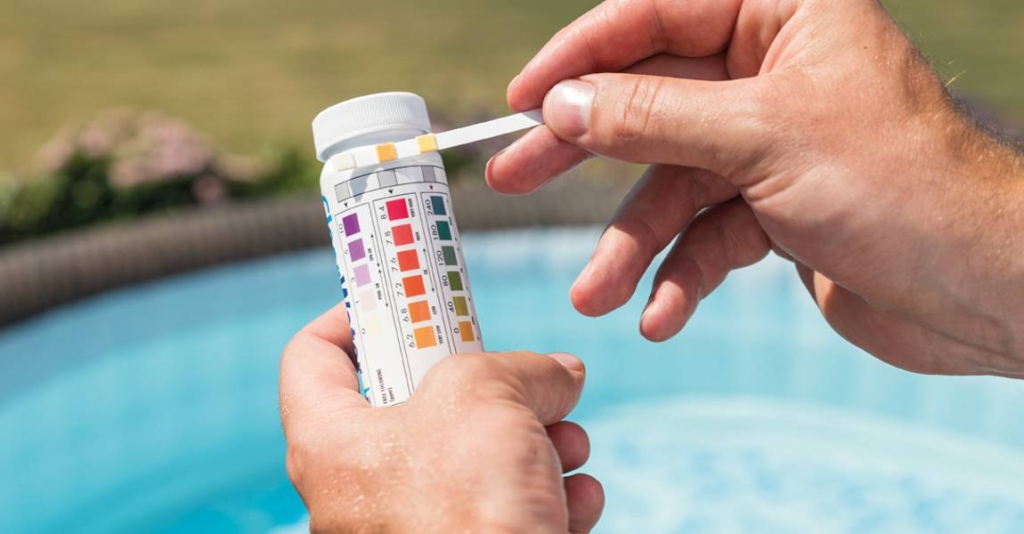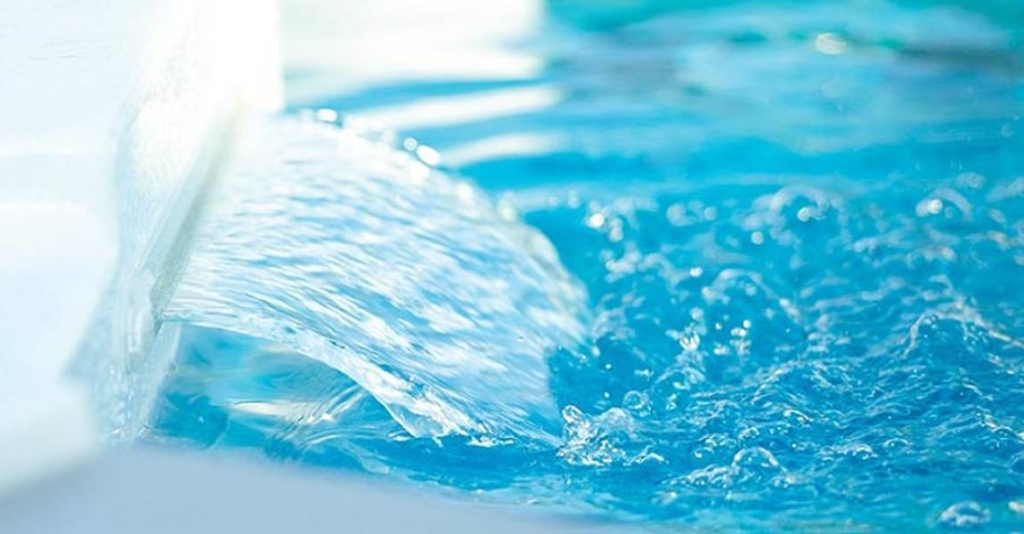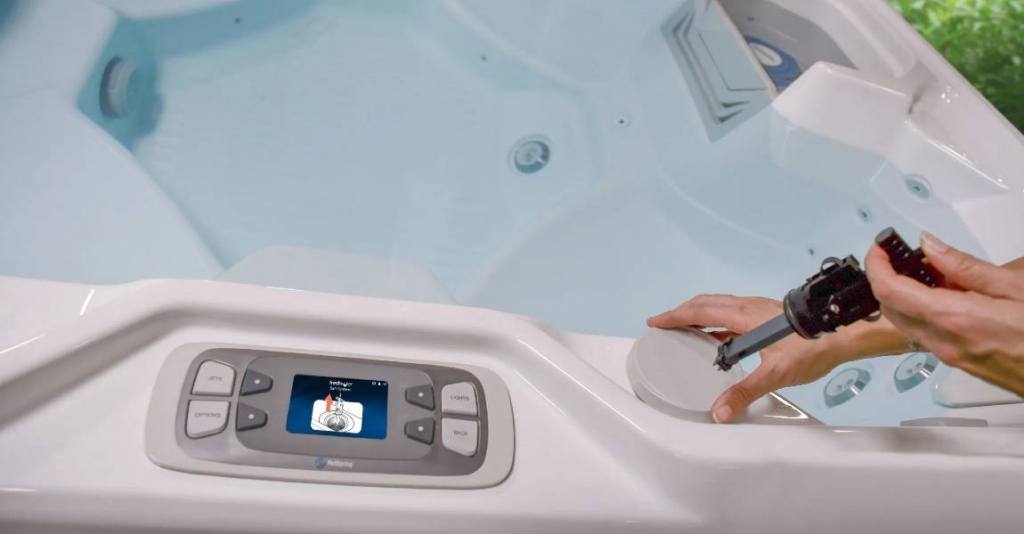If you recently got a hot tub or swim spa, maintenance is likely one of the foremost things on your mind. Some hot tub chemicals are essential to keeping the water clean and clear. And there are those that are merely optional. The order in which you add them is also of the utmost importance. Adding the wrong chemicals in the wrong order can be a recipe for disaster. But, of course, that’s what we want to avoid. Continue reading our Hot Tub Chemicals The Ultimate Water Care Guide:
So in this article, we discuss hot-tub chemistry, knowing what chemicals to add to your hot tub, and which is optional, when, and how to add them.
If you own a swim spa, you can care for it using the same chemicals as a hot tub.

- 5 Must-Have Hot Tub Chemicals
- Sanitizers
- pH Decreasers and Increasers
- Calcium Hardness Increaser
- Scale Remover Inhibitors
- Hot Tub Shock Treatment
- Optional Chemicals Your Hot Tub Could Use
- How to Correctly Add Chemicals to Hot Tub Water
- Correct Sequence for Adding Hot Tub Chemicals
5 Must-Have Hot Tub Chemicals
No one likes slimy algae and biofilm in their spa water. If you want to keep your hot tub clean and clear without any problems, below are essential chemicals you must add:
- Sanitizers
- pH increasers and decreasers
- Calcium hardness increaser
- Scale remover/inhibitors
- Shock Treatment
These chemicals will prevent any algae or bacteria build-up in your spa water. To keep your hot tub absolutely ugh-free, you’ll want to clean it regularly using specialized cleaning products. These products are specifically designed to kill any microorganisms and eliminate dirt rings around the tub’s rim.
So, let’s discuss the chemicals above in detail.
Sanitizers
Chemical sanitizers help disinfect your hot-tub and prevent algae and bacteria build-up. With the right sanitizer, no germ can survive there. This means the water will always look as clean as ever.
If you don’t use sanitizer, it will be filled with slimy materials in no time. So, this is a pretty much indispensable chemical for hot tub maintenance.
There are different kinds of sanitizers, and you need to decide which to use:
Chlorine Sanitizers
Most commercial tub owners use chlorine sanitizers because it’s pretty affordable and very effective. However, as chlorine kills off contaminants, it reacts with the water and produces chloramines. Chloramines cause the odor you perceive from chlorinated water. When you perceive this smell, it usually means the chlorine has been used up, and more needs to be added.
Chlorine is available as tablets or floaters. If you use chlorine for a hot tub or your swim spas maintenance, ensure you monitor the levels so you can remove the product once the level is balanced. The correct chlorine level is 1-3 ppm.
Bromine Sanitizers
An excellent alternative to chlorine sanitizer is bromine. This chemical ionizes the water and causes unwanted materials to degrade. Although it doesn’t have that smell that makes people dislike chlorine, bromine also comes with its downsides. It takes longer to dissolve and can leave your skin feeling sticky.
If you must use bromine sanitizer, ensure you rinse your body with clean water after indulging in the tub. It’s also not best for outdoor use as it will sublime quickly under the sun.
Oxygen Sanitizers
While these aren’t very popular, oxygen sanitizers are designed for people with sensitive skin type. They are milder but can kill germs and bacteria just as effectively. It’s advisable to add a tablet to the water any time you enter to get the levels right.

pH Decreasers and Increasers
One of the most confusing things about hot tubs is the pH. What’s the right pH level for your hot-tub? How do you get the pH levels right?
pH measures the degree of acidity or alkalinity of your tub. A high pH means the spa water is highly acidic (low alkalinity), leading to itchy skin and burning eyes. It will also prevent sanitizers from working effectively. On the other hand, low pH (low acidity and high alkalinity) can cause corrosion in the tub. The right balance is essential, making pH increasers and decreasers a must-have chemicals for your hot tub and swim spas.
The proper pH for your tub ranges between 7.4 and 7.6, while the total alkalinity should be between 80 and 120 mg/l ppm.
Add a pH decrease when your tub’s pH level rises beyond normal. And when it goes too low, add the pH increaser.
You may also decide to buy an alkalinity increaser. Note that when you lower the pH using a pH decreaser, the alkalinity also increases relatively. So having an alkalinity increaser isn’t always necessary.
In hot tub lingo, pH increasers and decreasers are known as balancing chemicals.
Calcium Hardness Increaser
The calcium hardness level of your spa should be between 150 and 250 ppm. If your pH, alkalinity, and calcium hardness are all in optimal ranges, your hot tub is said to be chemically balanced: zero worries about germs, bacteria, or corrosion.
But why is calcium hardness a thing? And why would you want to increase the calcium hardness of your hot tub? Well, if the water is too soft, it can eat away at the hot tub pipes and shell. That’s why you need to increase the hardness. But what if your calcium hardness gets too high and starts leaving calcium deposits? Your best bet is to drain the tub and refill it with fresh water.
Only add a little calcium increaser at a time to avoid getting the levels too high, as you can’t simply decrease it.
Scale Remover/Inhibitors
Over time, some mineral build-up will accumulate in your plumbing system and heating elements. When the hot-tub water begins to feel like sandpaper on your skin, that’s a tell-tale sign that you have scale in the tub.
To remove scale build-up, you’ll want to drain the water from the spas tub and apply scale remover to flush the grime out of the plumbing system. The chemical can also help to inhibit another accumulation. It’s best to flush your hot tub’s plumbing every 3-4 months.
Hot Tub Shock Treatment
A hot tub shock treatment is another essential chemical for your hot tub maintenance. When a cloud or algae is building up, a hot tub shock provides a large dose of sanitizer to eliminate the problem instantly. It’s best to shock your hot tub once a week to boost the effects of your sanitizer.
You will need a different type of shock treatment depending on your hot tub.
You can use either chlorine or non-chlorine shock for a chlorine or bromine hot tub. But we generally recommend chlorine shock because it’s more effective in killing germs.
For a mineral hot tub, use a non-chlorine shock; a chlorine shock is advised for a saltwater hot tub.

Optional Chemicals Your Hot Tub Could Use
Got some extra cash? Then having the following spa chemicals can give you an extra boost.
Hot Tub Clarifier
Its work is to clean up the water by collecting cloud-forming particles and expelling them through the hot tub filter or spa filter. However, a purifier only addresses the symptom of the problem and not the root cause, so if a pH imbalance caused the cloud, you could expect the water to get cloudy again soon.
Hot Tub Enzymes
Enzymes break down organic pollutants, such as body oils and skin cells, present in the hot tub. However, if you regularly apply sanitizers, keep the water balanced, and drain the hot-tub, you don’t need this chemical.
Filter Cleaner
You can clean your filters once a week using this chemical, but it’s not necessary unless your hot tub experiences heavy use during that short period.
How to Correctly Add Chemicals to Hot Tub Water
Before adding any chemicals to your hot tub, test the water. For example, you shouldn’t add a pH increaser unless you’ve tested the water and got a low pH reading. You’re going to need several test strips, and different types are available on the market, including liquid home test kits.
- Here’s how to add chemicals correctly to your spa water:
- First, heat the hot-tub to about 80°F. This will allow chemicals to dissolve more quickly.
- Measure the chemical to the quantity you need and pour it into the water.
- If you’re adding multiple chemicals to your tub, add one at a time. Never mix Chemicals, as there may be a reaction. Wait up to 20 minutes before pouring the next one. This will allow the first chemical enough time to dissolve. And ensure the jets are running and keep the valves off to facilitate quick and uniform dispersion.
- Stay safe by using goggles, gloves, and a mask when handling spa chemicals.
Correct Sequence for Adding Hot Tub Chemicals
- Add the scale remover first if you have just drained your hot tub water. This will prevent any minerals present from causing further damage.
- Then add a pH increaser or decreaser until the spa water reaches the desired level.
- Next, apply sanitizers. At a proper pH level, the sanitizer will be more effective.
- Finally, adjust your calcium hardness levels.
Remember, allow 20 minutes to elapse between additions. And ensure to add spa chemicals little by little to avoid pouring more than is necessary. That may lead to not only wastage but a need to drain the water, such as in the case of calcium hardness increaser.
You also don’t need to add shock when you drain your hot tub since it’s still full of fresh water. Only apply shock when you notice algae or cloudy water after some days or if the hot-tub is seeing heavy use.
Are you in the market for professional Denver swim spa or hot-tub installation service? Contact us today and learn how we can help you.

